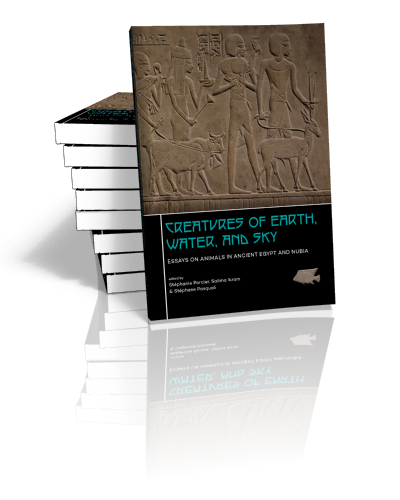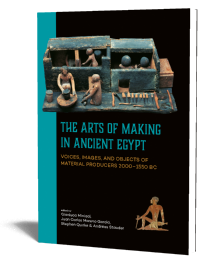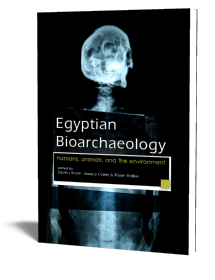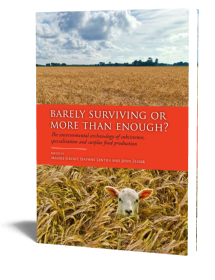Creatures of Earth, Water and Sky
Essays on Animals in Ancient Egypt and Nubia
Edited by Stéphanie Porcier, Salima Ikram & Stéphane Pasquali | 2019

Creatures of Earth, Water and Sky
Essays on Animals in Ancient Egypt and Nubia
Edited by Stéphanie Porcier, Salima Ikram & Stéphane Pasquali | 2019
Paperback ISBN: 9789088907722 | Hardback ISBN: 9789088907715 | Imprint: Sidestone Press | Format: 210x280mm | 356 pp. | Language: English & French | 75 illus. (bw) | 125 illus. (fc) | Keywords: ancient Egypt, mummy, mummification, bioarchaeology, Saqqara, Nubia, catacomb, animal necropolis, archaeozoology, disease, radiography, DNA, magic, domestication, lexicography, AMS dating, funerary practices, ritual practices, economy, predynastic | download cover
Read online or downloaded 2479 times
-
Digital & Online access
This is a full Open Access publication, click below to buy in print, browse, or download for free.
-
Buy via Sidestone (EU & UK)
-
Buy via our Distributors (WORLD)
For non-EU or UK destinations you can buy our books via our international distributors. Although prices may vary this will ensure speedy delivery and reduction in shipping costs or import tax. But you can also order with us directly via the module above.
UK international distributor
USA international distributor
-
Bookinfo
Paperback ISBN: 9789088907722 | Hardback ISBN: 9789088907715 | Imprint: Sidestone Press | Format: 210x280mm | 356 pp. | Language: English & French | 75 illus. (bw) | 125 illus. (fc) | Keywords: ancient Egypt, mummy, mummification, bioarchaeology, Saqqara, Nubia, catacomb, animal necropolis, archaeozoology, disease, radiography, DNA, magic, domestication, lexicography, AMS dating, funerary practices, ritual practices, economy, predynastic | download cover
Read online or downloaded 2479 times

We will plant a tree for each order containing a paperback or hardback book via OneTreePlanted.org.
Ancient Egyptians always had an intense and complex relationship with animals in daily life as well as in religion. Despite the fact that research on this relationship has been a topic of study, gaps in our knowledge still remain. This volume presents well over 30 contributions that explore Human-Animal relationships from the Predynastic to the Roman period.
The essays cover topics such as animal husbandry, mummification, species-specific studies, the archaeology and economy of the animal cults, funerary practices, iconography and symbolism. The contribution of archaeometrical methods, such as DNA analyses, balms’ analyses, AMS dating, radiography, and 3D imaging, are also represented as these play a significant role in furthering our understanding of the human-animal relationship in Egypt.
The range of subject matter and contributors are indicative of the importance of animals and the role that they played in ancient Egypt and Nubia, and emphasises the need for continued inter- and multidisciplinary studies on the subject. The research outlined in this volume has helped, for example, to better identify ways of sourcing the animals used in mummification, contributed to establishing the eras during which animal mummification became common, and highlighted new techniques for acquiring DNA.
The fresh insights and diversity of topics makes the volume of interest for professionals (Egyptologists, (archaeo-)zoologists and historians), as well as those who are interested in Egyptology and in the relationship between humans and animals. ‘Creatures of Earth, Water and Sky’ is the result of the first international conference ever dedicated to animals in ancient Egypt and Nubia (the International Symposium on Animals in Ancient Egypt, ISAAE 1, June 1-3 2016, held in Lyon).
Abstracts
Preface
Stéphanie Porcier, Salima Ikram & Stéphane Pasquali
L’exploitation de l’autruche dans l’Égypte ancienne : l’exemple des perles en coquille d’œuf d’autruche
Halima Ali Toybou
Scanning Sobek: Mummy of the Crocodile God
Julie Anderson & Daniel Antoine
Donkey Burials at Tell El-Yahudia
Aiman Ashmawy Ali
À propos des noms d’espèces appartenant au sous-ordre des sauria (lézards) attestés en Égypte ancienne et médiévale : un tour d’horizon zoologique et lexicographique
Sydney H. Aufrère
Early Travellers and the Animal `Mummy Pits’ of Egypt: Exploration and Exploitation of the Animal Catacombs in the Age of Early Travel
Tessa T. Baber
From Egyptology to Ornithology: The Cults of Sacred Falcons and The Musée des Confluences’ Raptor Mummies
Rozenn Bailleul-LeSuer
Interpreting the Faunal Remains from the Tombs at the Temple of Millions of Years of Amenhotep II in Western Thebes: Funerary Practices, Ritual Practices or, Perhaps, Something Else?
Fabio Bona, Anna Consonni, Tommaso Quirino & Angelo Sesana
Une analyse chimique de la composition de baumes de momies animales égyptiennes conservées au musée des Confluences (Lyon, France)
Manon Bondetti, Stéphanie Porcier, Matthieu Ménager & Cathy Vieillescazes
Économie du culte des animaux sacrés en Égypte hellénistique et romaine
Silvia Bussi
Bœufs d’Égypte, bœufs du Soudan : une morphologie différente ?
Louis Chaix
L’étude des momies animales du musée des Confluences à Lyon. L’exemple des momies de poissons
Alain Charron
Des chiens et des bandelettes
Françoise Dunand, Roger Lichtenberg, Cécile Callou & Fleur Letellier-Willemin
Trapping Baqet’s Rat
Linda Evans
De la valeur emblématique des dromadaires en terre cuite d’Égypte
Jérôme Gonzalez
Formes et figures animales dans le mobilier égyptien
Hélène Guichard
Shedding New Light on Old Corpses: Developments in the Field of Animal Mummy Studies
Salima Ikram
Mummies from the City of Canine Deities: An Analysis of Canid Osteofaunal Remains from the Tomb of the Dogs on Gebel Asyut al-Gharbi, Asyut, Middle Egypt
Chiori Kitagawa
Emploi et symbolisme des cornes de bovins au Protodynastique : Exemples d’Abou Rawach
Joséphine Lesur
Appréhender les momies autrement. L’étude des textiles des momies de gazelles du musée des Confluences à Lyon
Fleur Letellier-Willemin
Known and Unknown Animals in a Bilingual Glossary on a Papyrus from Egypt, and the Egyptian Effect on the Small Animal of Callimachus
Nikos Litinas
Mummies at Manchester – applying the Manchester Methodology to the Study of Mummified Animal Remains from Ancient Egypt
Lidija McKnight & Stephanie Woolham
The North Ibis Catacomb at Saqqara
Paul T. Nicholson
The Conservation of Animal Mummies: Problems and Possible Solutions
Cinzia Oliva & Matilde Borla
La polychromie d’un cercueil de faucon d’époque romaine
Sandrine Pagès-Camagna & Yannick Vandenberghe
Sur la manière dont un Égyptien a raconté l’installation de l’animal sacré de Mendès
Stéphane Pasquali
Datations par le carbone 14 de 63 momies animales du musée des Confluences à Lyon (France)
Stéphanie Porcier, Pascale Richardin, Gaëtan Louarn, Salima Ikram & Didier Berthet
Les cinq momies de chat de la Società africana d’Italia (SAI) : nouvelles recherches, nouvelles découvertes
Maria Diletta Pubblico & Cinzia Oliva
The Burial Ground for Osiris-(NN)-Animals at Tuna el-Gebel
Katrin Annikka Schlüter
A Study of the Wrapping of an Ibis Mummy from the Catacombs of Tuna-el-Gebel, Hermopolis
Ahmed Tarek, Mohamed Abdel-Rahman, Nesma Mohamed, Ahmed Khairy & Ahmed Abedellatif
The Conservation of Animal Mummies and Associated Materials: Case Studies from the C2RMF
Noëlle Timbart
Le ‘Tête-de-chien’ (κυνοκέφαλος) des Grecs : l’Égypte au prisme des animaux
Marco Vespa
‘Fishing’ for Mitochondrial DNA in Mummified Sacred Ibis: Development of a Targeted Enrichment Protocol Resolves the Ancient Egyptian DNA Survival Debate
Sally Wasef, Leon Huynen, Craig Donald Millar, Sankar Subramanian, Salima Ikram, Barbra Holland Eske Willerslev & David Martin Lambert
Salima Ikram
Salima Ikram is Distinguished University Professor of Egyptology at the American University in Cairo, and has excavated extensively in Egypt as well as in Turkey. She has directed the Animal Mummy Project, the Amenmesse Project (KV10/KV63), the North Kharga Oasis Darb Ain Amur Project, and headed the archaeozoology team at Kinet Hoyuk in Turkey.
Stéphane Pasquali
Stéphane Pasquali is Lecturer at the University Paul-Valéry Montpellier 3 (France) where he teaches Egyptology and conducts research on Written and Material Culture. He has recently published scientific papers about texts as objects and texts as creations, as well as on the reception of Pharaonic Egypt in Medieval Egypt.
Stéphanie Porcier
Stéphanie Porcier is an Egyptologist and Archeozoologist specializing in the study of animals in ancient Egypt and especially animal mummies. She directs the inter- and multidisciplinary program MAHES (French acronym for Egyptian Animal and Human Mummies) which aims to study the most important collection of animal mummies outside Egypt kept at the Musée des Confluences, Lyon (France).
Abstract:
Ancient Egyptians always had an intense and complex relationship with animals in daily life as well as in religion. Despite the fact that research on this relationship has been a topic of study, gaps in our knowledge still remain. This volume presents well over 30 contributions that explore Human-Animal relationships from the Predynastic to the Roman period.
The essays cover topics such as animal husbandry, mummification, species-specific studies, the archaeology and economy of the animal cults, funerary practices, iconography and symbolism. The contribution of archaeometrical methods, such as DNA analyses, balms’ analyses, AMS dating, radiography, and 3D imaging, are also represented as these play a significant role in furthering our understanding of the human-animal relationship in Egypt.
The range of subject matter and contributors are indicative of the importance of animals and the role that they played in ancient Egypt and Nubia, and emphasises the need for continued inter- and multidisciplinary studies on the subject. The research outlined in this volume has helped, for example, to better identify ways of sourcing the animals used in mummification, contributed to establishing the eras during which animal mummification became common, and highlighted new techniques for acquiring DNA.
The fresh insights and diversity of topics makes the volume of interest for professionals (Egyptologists, (archaeo-)zoologists and historians), as well as those who are interested in Egyptology and in the relationship between humans and animals. ‘Creatures of Earth, Water and Sky’ is the result of the first international conference ever dedicated to animals in ancient Egypt and Nubia (the International Symposium on Animals in Ancient Egypt, ISAAE 1, June 1-3 2016, held in Lyon).
Contents
Abstracts
Preface
Stéphanie Porcier, Salima Ikram & Stéphane Pasquali
L’exploitation de l’autruche dans l’Égypte ancienne : l’exemple des perles en coquille d’œuf d’autruche
Halima Ali Toybou
Scanning Sobek: Mummy of the Crocodile God
Julie Anderson & Daniel Antoine
Donkey Burials at Tell El-Yahudia
Aiman Ashmawy Ali
À propos des noms d’espèces appartenant au sous-ordre des sauria (lézards) attestés en Égypte ancienne et médiévale : un tour d’horizon zoologique et lexicographique
Sydney H. Aufrère
Early Travellers and the Animal `Mummy Pits’ of Egypt: Exploration and Exploitation of the Animal Catacombs in the Age of Early Travel
Tessa T. Baber
From Egyptology to Ornithology: The Cults of Sacred Falcons and The Musée des Confluences’ Raptor Mummies
Rozenn Bailleul-LeSuer
Interpreting the Faunal Remains from the Tombs at the Temple of Millions of Years of Amenhotep II in Western Thebes: Funerary Practices, Ritual Practices or, Perhaps, Something Else?
Fabio Bona, Anna Consonni, Tommaso Quirino & Angelo Sesana
Une analyse chimique de la composition de baumes de momies animales égyptiennes conservées au musée des Confluences (Lyon, France)
Manon Bondetti, Stéphanie Porcier, Matthieu Ménager & Cathy Vieillescazes
Économie du culte des animaux sacrés en Égypte hellénistique et romaine
Silvia Bussi
Bœufs d’Égypte, bœufs du Soudan : une morphologie différente ?
Louis Chaix
L’étude des momies animales du musée des Confluences à Lyon. L’exemple des momies de poissons
Alain Charron
Des chiens et des bandelettes
Françoise Dunand, Roger Lichtenberg, Cécile Callou & Fleur Letellier-Willemin
Trapping Baqet’s Rat
Linda Evans
De la valeur emblématique des dromadaires en terre cuite d’Égypte
Jérôme Gonzalez
Formes et figures animales dans le mobilier égyptien
Hélène Guichard
Shedding New Light on Old Corpses: Developments in the Field of Animal Mummy Studies
Salima Ikram
Mummies from the City of Canine Deities: An Analysis of Canid Osteofaunal Remains from the Tomb of the Dogs on Gebel Asyut al-Gharbi, Asyut, Middle Egypt
Chiori Kitagawa
Emploi et symbolisme des cornes de bovins au Protodynastique : Exemples d’Abou Rawach
Joséphine Lesur
Appréhender les momies autrement. L’étude des textiles des momies de gazelles du musée des Confluences à Lyon
Fleur Letellier-Willemin
Known and Unknown Animals in a Bilingual Glossary on a Papyrus from Egypt, and the Egyptian Effect on the Small Animal of Callimachus
Nikos Litinas
Mummies at Manchester – applying the Manchester Methodology to the Study of Mummified Animal Remains from Ancient Egypt
Lidija McKnight & Stephanie Woolham
The North Ibis Catacomb at Saqqara
Paul T. Nicholson
The Conservation of Animal Mummies: Problems and Possible Solutions
Cinzia Oliva & Matilde Borla
La polychromie d’un cercueil de faucon d’époque romaine
Sandrine Pagès-Camagna & Yannick Vandenberghe
Sur la manière dont un Égyptien a raconté l’installation de l’animal sacré de Mendès
Stéphane Pasquali
Datations par le carbone 14 de 63 momies animales du musée des Confluences à Lyon (France)
Stéphanie Porcier, Pascale Richardin, Gaëtan Louarn, Salima Ikram & Didier Berthet
Les cinq momies de chat de la Società africana d’Italia (SAI) : nouvelles recherches, nouvelles découvertes
Maria Diletta Pubblico & Cinzia Oliva
The Burial Ground for Osiris-(NN)-Animals at Tuna el-Gebel
Katrin Annikka Schlüter
A Study of the Wrapping of an Ibis Mummy from the Catacombs of Tuna-el-Gebel, Hermopolis
Ahmed Tarek, Mohamed Abdel-Rahman, Nesma Mohamed, Ahmed Khairy & Ahmed Abedellatif
The Conservation of Animal Mummies and Associated Materials: Case Studies from the C2RMF
Noëlle Timbart
Le ‘Tête-de-chien’ (κυνοκέφαλος) des Grecs : l’Égypte au prisme des animaux
Marco Vespa
‘Fishing’ for Mitochondrial DNA in Mummified Sacred Ibis: Development of a Targeted Enrichment Protocol Resolves the Ancient Egyptian DNA Survival Debate
Sally Wasef, Leon Huynen, Craig Donald Millar, Sankar Subramanian, Salima Ikram, Barbra Holland Eske Willerslev & David Martin Lambert
Salima Ikram
Salima Ikram is Distinguished University Professor of Egyptology at the American University in Cairo, and has excavated extensively in Egypt as well as in Turkey. She has directed the Animal Mummy Project, the Amenmesse Project (KV10/KV63), the North Kharga Oasis Darb Ain Amur Project, and headed the archaeozoology team at Kinet Hoyuk in Turkey.
Stéphane Pasquali
Stéphane Pasquali is Lecturer at the University Paul-Valéry Montpellier 3 (France) where he teaches Egyptology and conducts research on Written and Material Culture. He has recently published scientific papers about texts as objects and texts as creations, as well as on the reception of Pharaonic Egypt in Medieval Egypt.
Stéphanie Porcier
Stéphanie Porcier is an Egyptologist and Archeozoologist specializing in the study of animals in ancient Egypt and especially animal mummies. She directs the inter- and multidisciplinary program MAHES (French acronym for Egyptian Animal and Human Mummies) which aims to study the most important collection of animal mummies outside Egypt kept at the Musée des Confluences, Lyon (France).
-
Digital & Online access
This is a full Open Access publication, click below to buy in print, browse, or download for free.
-
Buy via Sidestone (EU & UK)
-
Buy via our Distributors (WORLD)
For non-EU or UK destinations you can buy our books via our international distributors. Although prices may vary this will ensure speedy delivery and reduction in shipping costs or import tax. But you can also order with us directly via the module above.
UK international distributor
USA international distributor
- Browse all books by subject
-
Search all books

We will plant a tree for each order containing a paperback or hardback book via OneTreePlanted.org.
You might also like:
© 2025 Sidestone Press KvK nr. 28114891 Privacy policy Sidestone Newsletter Terms and Conditions (Dutch)








